Petal power Discarded flowers and botanicals offer up a spectrum of natural fabric dyes
Read this article for free:
or
Already have an account? Log in here »
To continue reading, please subscribe:
Monthly Digital Subscription
$0 for the first 4 weeks*
- Enjoy unlimited reading on winnipegfreepress.com
- Read the E-Edition, our digital replica newspaper
- Access News Break, our award-winning app
- Play interactive puzzles
*No charge for 4 weeks then price increases to the regular rate of $19.00 plus GST every four weeks. Offer available to new and qualified returning subscribers only. Cancel any time.
Monthly Digital Subscription
$4.75/week*
- Enjoy unlimited reading on winnipegfreepress.com
- Read the E-Edition, our digital replica newspaper
- Access News Break, our award-winning app
- Play interactive puzzles
*Billed as $19 plus GST every four weeks. Cancel any time.
To continue reading, please subscribe:
Add Free Press access to your Brandon Sun subscription for only an additional
$1 for the first 4 weeks*
*Your next subscription payment will increase by $1.00 and you will be charged $16.99 plus GST for four weeks. After four weeks, your payment will increase to $23.99 plus GST every four weeks.
Read unlimited articles for free today:
or
Already have an account? Log in here »
Hey there, time traveller!
This article was published 08/03/2024 (627 days ago), so information in it may no longer be current.
Lourdes Still has her fingers wrapped around a mug of hot steaming tea as she awaits guests in her studio-in-the-woods at Masagana Flower Farm.
The kettle is on the stove, there are snacks laid out on the side and in the middle of the room a large wooden table dominates, the worktop covered with glass jars and woven baskets holding a variety of dried blooms.
Hanging off the beams of the studio ceiling are even more flowers, bouquets tied together with twine, hanging upside down.
Outside the sky is a leaden grey, and there’s a scant covering of white on the ground. It’s a chilly winter’s day but here we are ensconced in warmth as Still animatedly explains what’s involved in her inaugural winter floral dyeing workshop.
BROOK JONES / FREE PRESS Lourdes Still explains the process of dyeing fabric with dried flower blooms.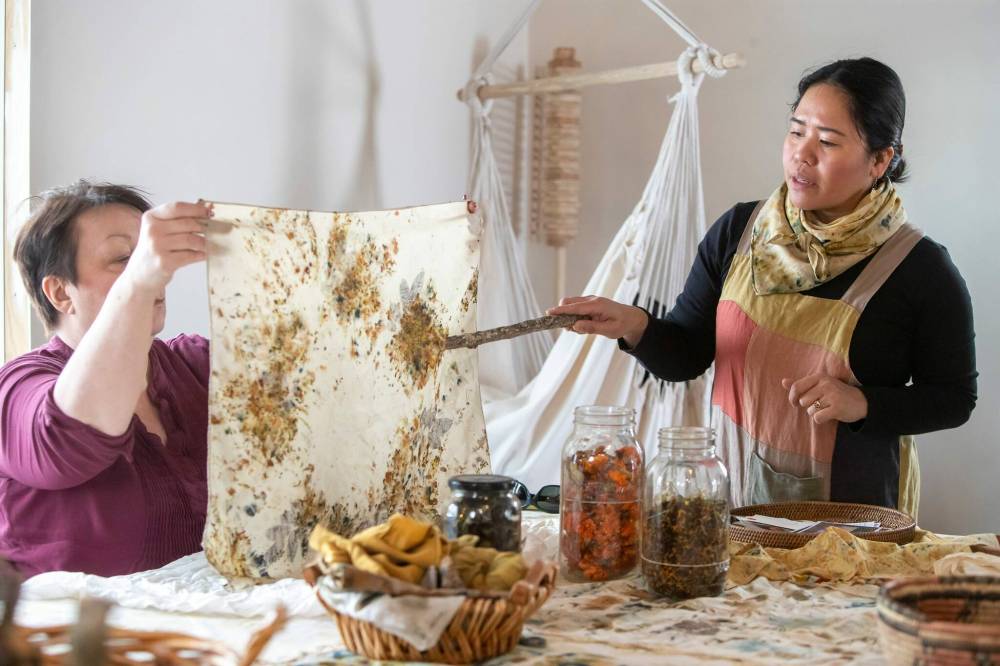
Still usually runs her Tinta flower dyeing experiences in the summer at her homestead an hour east of Winnipeg between the towns of La Broquerie and Richer. Participants wander around her farm, picking their own flowers before learning how to use them to dye their textiles. The fabrics they work with are larger, and the dyeing process results in more vibrant and solid colours as the intense shades of the fresh flowers transfer themselves to the cloth.
We will be doing one part of the full Tinta. During our three-hour experience we will use flowers Still grew last year to dye a silk scarf and a cotton bandana. We will also be using food and floral waste such as onion skins and discarded petals.
BROOK JONES / FREE PRESS Dried flowers hang from the rafters in Still’s studio.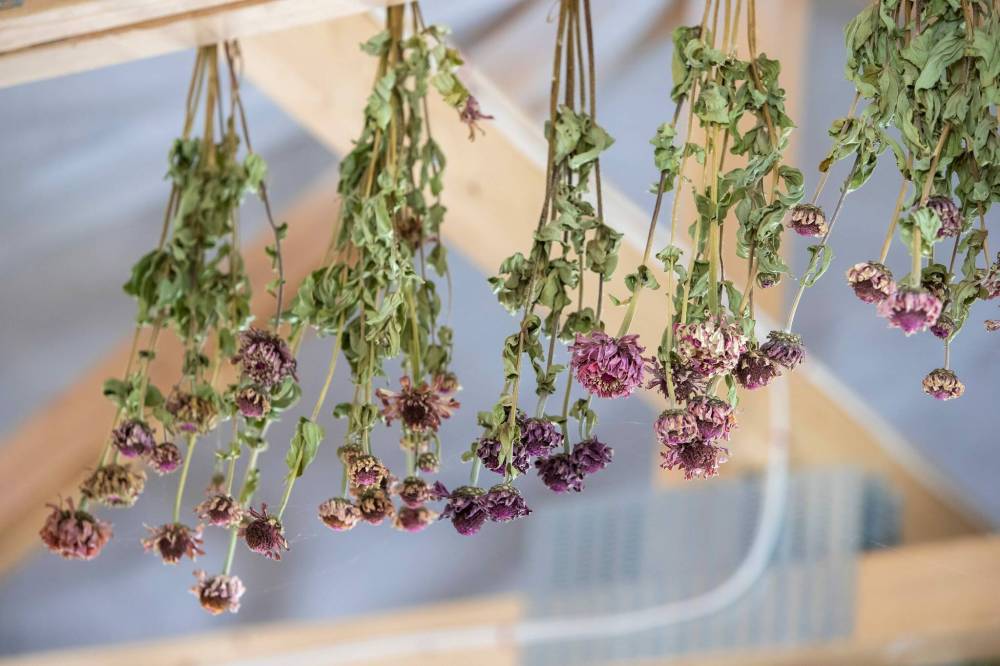
Previously a wholesale flower buyer, Still established Masagana — which means abundant, plentiful and prosperous in her mother tongue, Tagalog — with the purpose of growing seasonal blooms and cultivating dye plants to make small-batch, handmade, naturally dyed textiles.
She started off as a self-taught flower farmer, natural dyer and tourism operator, but has since trained through industry leaders such as Floret Farm, Maiwa School of Textiles and Earth Rhythms.
“A big part of why I started Masagana is to inspire others to get rid of their lawns and replace them with plants or edible gardens,” she says.
When Still first grew flowers to sell in 2018, she was overwhelmed by how much her garden was producing. Plants that didn’t pass the quality check to be sold as bouquets would fill up her house and compost bins. Although the plants ultimately returned to the land, she was unsettled by the waste.
Upcoming Masagana Flower Farm experiences
March 30
Grow Your Dye Garden Workshop $160
Learn how to start plants from seeds using soil blocking, how to plan your garden and how to identify Manitoba plants to use as natural dye sources. Includes a mini floral-dyeing experience.
March 30
Grow Your Dye Garden Workshop $160
Learn how to start plants from seeds using soil blocking, how to plan your garden and how to identify Manitoba plants to use as natural dye sources. Includes a mini floral-dyeing experience.
Summer dates to be confirmed at masaganafarmexperiences.as.me
Full Tinta Experience, $295
Design a silk scarf with flowers you pick and make an indigo-dyed cotton shawl. Materials included for both creations.
Floral Dyeing Experience, $160
Design your silk scarf with picked flowers.
Indigo Dyeing Experience, $160
Learn about the magic of indigo and then design your own cotton shawl.
A workshop at a fibre farm, where farmers grew plants that would become botanical dye sources for their wool yarns, planted the seed of an idea.
“We have a very short growing season in Manitoba and after learning about natural dyeing using indigo and flowers at Long Way Homestead’s Eco-printing workshop in 2019, I thought I should diversify to include those plants in my crop planning,” she says. “As years went by, I found my strength in running on-farm workshops and now focus on offering experiential tourism, and growing mostly just flowers and plants that can be used as natural dye sources.”
Before the dyeing experience starts, the attendees — there are four of us, including Hillary Dux, who is here with her mother, Colleen, and Karie Mooney — are invited to join Still in her grounding meditation practice before moving on to learn about the textiles we will be working with.
Both the silk and cotton materials have been treated before our arrival to ensure the natural dyes successfully transfer to the cloth. Still scoured the cottons, cleaning off impurities the materials picked up during the manufacturing process. She also prepared the fibres to accept the dyes by mordanting the materials. Mordanting is one of the most important steps in the pre-dyeing process, facilitating the binding between the natural dye and the textile.
We pass around shallow baskets holding hundreds of red rose petals that were meant to be discarded. The glass jars and bottles contain dried marigolds, coreopsis, black night scabiosa, dyers chamomile, also known as golden Marguerite, and orange cosmos, all from her farm and all natural dye sources.
BROOK JONES / FREE PRESS Dried blooms from flowers such as marigolds are used for dyeing fabric.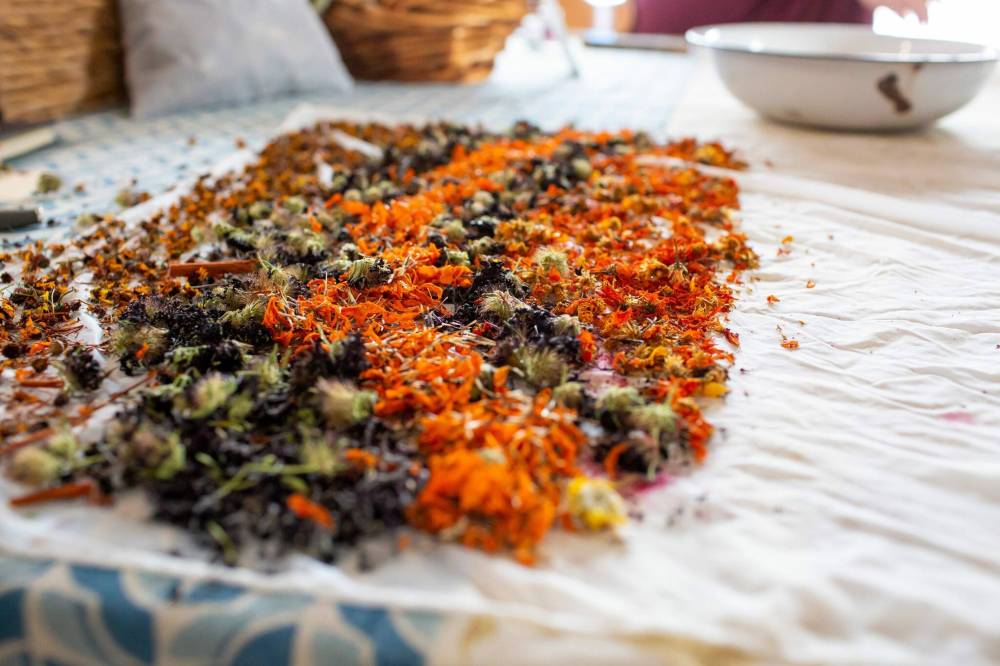
In a small bowl there is also dried dahlia she grew from seeds. The dye produced from dried flowers is not as vibrant as those from fresh petals, so we also have a bottle of cochineal, a bug harvested from cacti, and logwood chips, which will give us a deep purple colour.
Before we begin laying out our flowers, Still reminds us to manage our expectations.
“One of the characteristics of natural dyeing is that you cannot expect it to be completely solid. There will always be imperfections, which is the exact opposite of the things we purchase when we buy synthetically coloured garments. We want the perfect colour when we purchase clothes, but when it comes to natural dyes, you have to embrace the imperfections,” she explains.
BROOK JONES / FREE PRESS Still steams bundles of silk and dried flower blooms as part of her workshop’s fabric dyeing process.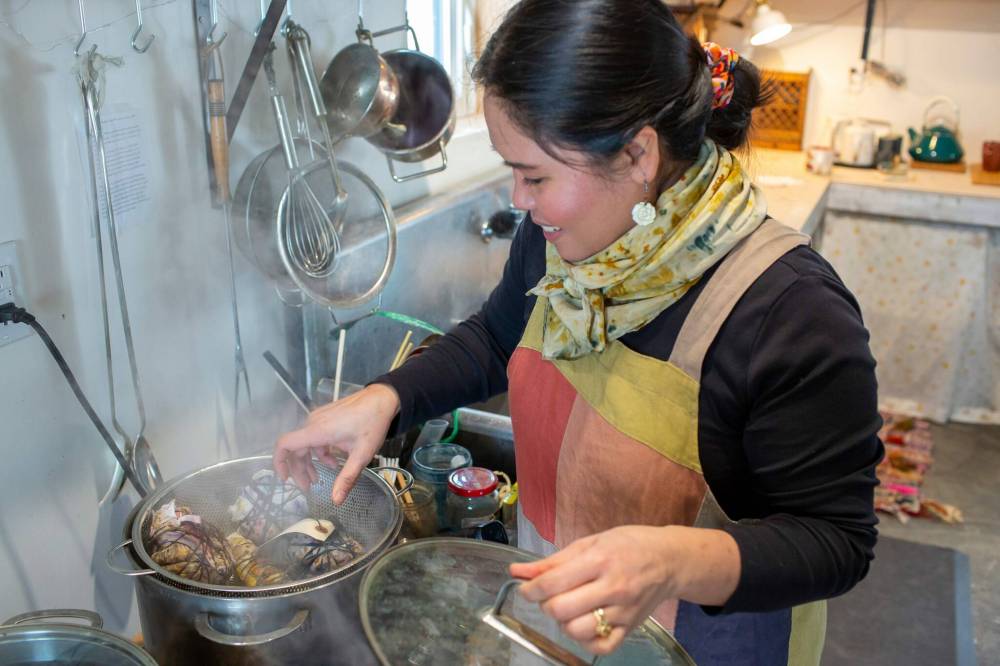
We start off with the silks. Each participant soaks her cloth in a bowl of water and wrings out the excess before laying it flat.
We choose the botanicals we prefer and plot out our patterns. I have chosen to use marigolds, black knight scabiosa and dyers chamomile, the petals of which I scatter purposefully in ever-increasing crescent on one half of the material. I want a circular pattern in my scarf, which will (hopefully!) be achieved when the material is folded and rolled.
This folding and rolling will create a mirror image, although Still warns there might be “shadows” or “ghosts” in our pieces after dyeing.
“This is because of the amount of layers. The first contact of the botanicals into the textile will have the highest saturation, and then when you are rolling it, you are adding layers and layers of fabric so the further it is from the plants and flowers, the less transfer there is to the material,” she says.
BROOK JONES / FREE PRESS Silk bandanas are still tied up into a ball after being steamed during the fabric dyeing process.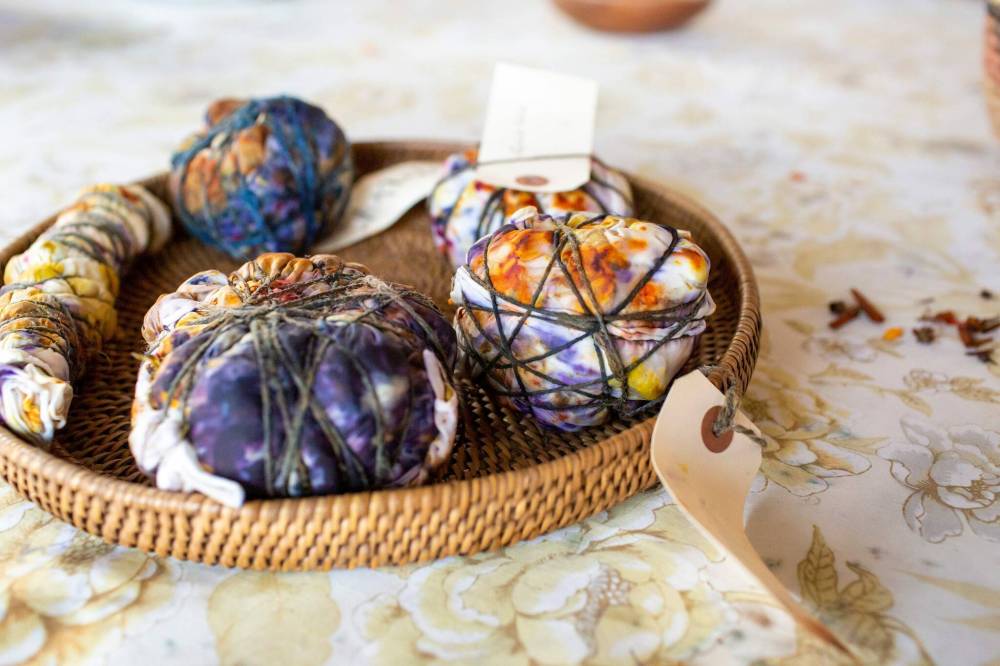
Still sprays the dried blooms with water. Keeping the flowers moist throughout is imperative to ensure they remain in place during the folding process. As soon as I am happy with the placement, I start folding the material. Once the cloth is folded into a quarter of its size, it is rolled tightly into a sausage shape, pressing down to ensure no blooms escape. The rolled material is then wound into a tight cinnamon-bun knot and secured with hemp twine.
The completed packet is then steamed, 10 minutes on each side, over a boiling pot.
There is a vegetal scent in the air as the plants, aided by steam, imprint their shapes and colours into the material. While the silks steam, we start work on the cotton, repeating the process with different flowers and patterns.
When our materials are ready, we remove the packets from the steamer with tongs, waiting impatiently for them to cool down before we start unwrapping them to exclamations of delight. It’s a magical moment, seeing our plain white textiles transformed into works of art made using just dried flowers and discarded botanicals.
Photos by BROOK JONES / FREE PRESS Still (centre) is flanked by participants Karie Mooney (from left), Hillary Dux, her mother Colleen Dux and Free Press writer AV Kitching as they show off the silk bandanas they dyed with dried flower blooms.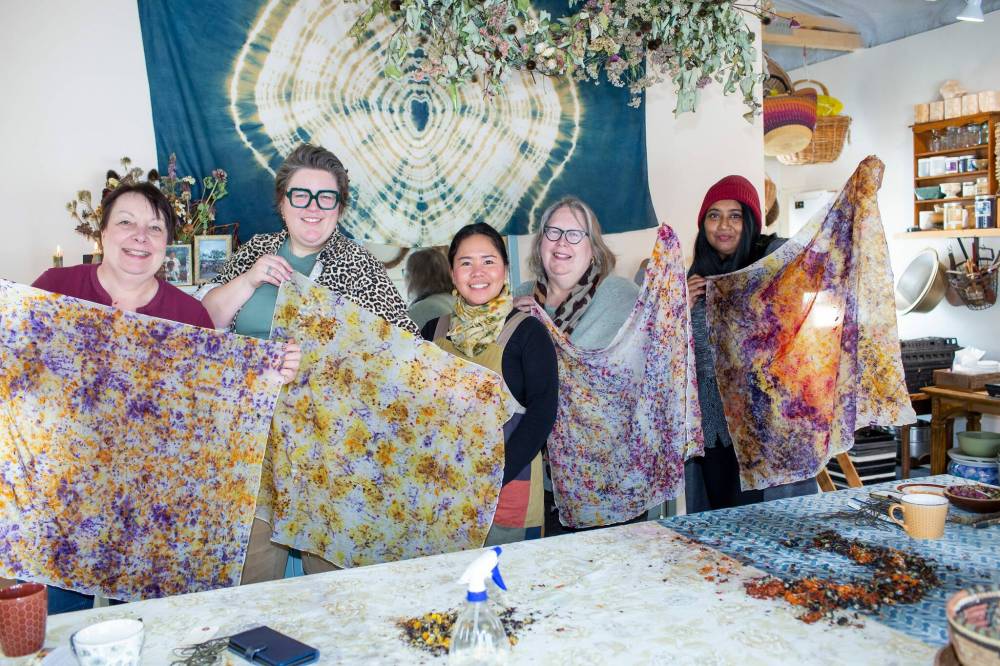
av.kitching@freepress.mb.ca

AV Kitching is an arts and life writer at the Free Press. She has been a journalist for more than two decades and has worked across three continents writing about people, travel, food, and fashion. Read more about AV.
Every piece of reporting AV produces is reviewed by an editing team before it is posted online or published in print — part of the Free Press‘s tradition, since 1872, of producing reliable independent journalism. Read more about Free Press’s history and mandate, and learn how our newsroom operates.
Our newsroom depends on a growing audience of readers to power our journalism. If you are not a paid reader, please consider becoming a subscriber.
Our newsroom depends on its audience of readers to power our journalism. Thank you for your support.
